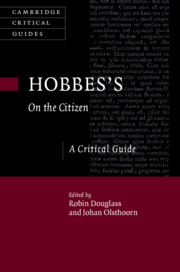Book contents
- Hobbes’s On the Citizen
- Cambridge Critical Guides
- Hobbes’s On the Citizen
- Copyright page
- Contents
- Contributors
- Acknowledgments
- Abbreviations
- Introduction
- Chapter 1 Excavating On the Citizen
- Chapter 2 Hobbes and Aristotle on the Foundation of Political Science
- Chapter 3 All the Mind’s Pleasure: Glory, Self-Admiration, and Moral Motivation in On the Citizen and Leviathan
- Chapter 4 The Right of Nature and Political Disobedience: Hobbes’s Puzzling Thought Experiment
- Chapter 5 Motivation, Reason, and the Good in On the Citizen
- Chapter 6 Property and Despotic Sovereignty
- Chapter 7 Sovereignty and Dominium: The Foundations of Hobbesian Statehood
- Chapter 8 Corporate Persons without Authorization
- Chapter 9 Hobbes on Love and Fear of God
- Chapter 10 “A Rhapsody of Heresies”: The Scriptural Politics of On the Citizen
- Chapter 11 On the Citizen and Church-State Relations
- Chapter 12 Sovereign-Making and Biblical Covenants in On the Citizen
- Bibliography
- Index
- Cambridge Critical Guides
Chapter 7 - Sovereignty and Dominium: The Foundations of Hobbesian Statehood
Published online by Cambridge University Press: 15 November 2019
- Hobbes’s On the Citizen
- Cambridge Critical Guides
- Hobbes’s On the Citizen
- Copyright page
- Contents
- Contributors
- Acknowledgments
- Abbreviations
- Introduction
- Chapter 1 Excavating On the Citizen
- Chapter 2 Hobbes and Aristotle on the Foundation of Political Science
- Chapter 3 All the Mind’s Pleasure: Glory, Self-Admiration, and Moral Motivation in On the Citizen and Leviathan
- Chapter 4 The Right of Nature and Political Disobedience: Hobbes’s Puzzling Thought Experiment
- Chapter 5 Motivation, Reason, and the Good in On the Citizen
- Chapter 6 Property and Despotic Sovereignty
- Chapter 7 Sovereignty and Dominium: The Foundations of Hobbesian Statehood
- Chapter 8 Corporate Persons without Authorization
- Chapter 9 Hobbes on Love and Fear of God
- Chapter 10 “A Rhapsody of Heresies”: The Scriptural Politics of On the Citizen
- Chapter 11 On the Citizen and Church-State Relations
- Chapter 12 Sovereign-Making and Biblical Covenants in On the Citizen
- Bibliography
- Index
- Cambridge Critical Guides
Summary
Chapters 8 and 9 of On the Citizen present a theory of sovereignty that Hobbes modeled on the master-slave relationship of dominium. To be a sovereign over a state, according to that theory, is really to be a kind of dominus over slaves. The usual view (based on Leviathan, chapter 20) is that this “despotic” form of sovereignty was limited only to those states described by Hobbes as “natural” or “acquired.” This chapter, however, argues that the despotic model of dominium in alterius personam functioned as a general theory of sovereignty to be found in all sovereign states, even in those states instituted, as Hobbes put it, “by mutual pact.” Indeed, the Hobbesian distinction between “instituted” and “acquired” states was not really a difference in the substance of sovereignty. Rather, it was only a difference in how sovereignty was to be constituted and dissolved. The chapter shows that it was originally intended to map onto the Aristotelian distinction between “correct” and “deviant” constitutions. However a state is constituted, Hobbes’s larger point was that statehood always requires dominium, since it is what ultimately activates the bond of obligation making a state more than just a mere association of duty-free individuals.
- Type
- Chapter
- Information
- Hobbes's On the CitizenA Critical Guide, pp. 126 - 144Publisher: Cambridge University PressPrint publication year: 2019
- 1
- Cited by

